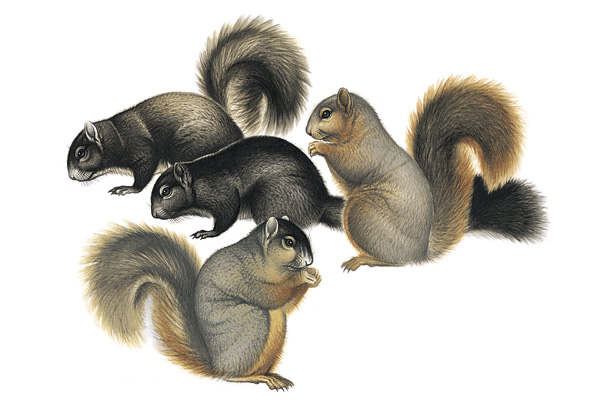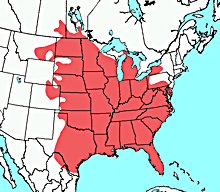 Painting by Todd Zalewski from Kays and
Wilson's Mammals of North America, © Princeton
University Press (2002)
Painting by Todd Zalewski from Kays and
Wilson's Mammals of North America, © Princeton
University Press (2002)
|
|
Description |
Fox squirrels are a
medium-sized tree squirrel with no sexual dimorphism. The dorsal
pelage is buff to orange and the venter is rufous. Some varieties in
the southeastern United States are black. These squirrels have 8
mammae. Tail is well furred. Ear tufts often develop in winter.
Adaptations for climbing
include sharp recurved claws, well developed extensors of digits and
flexors of forearms, and abdominal musculature
Length:
Range: 454-698 mm
Weight:
Range: 696-1,233 g
|
|
Range Map |
|
Taxonomic Hierarchy |

Fox squirrels are found throughout the eastern and central
United States, south into northern Mexico, and north into
Canada. They have been introduced into urban areas in
western North America as well. |
|
Kingdom: |
Animalia |
|
Phylum: |
Chordata |
|
Subphylum: |
Vertebrata |
|
Class: |
Mammalia |
|
Subclass: |
Theria |
|
Infraclass: |
Eutheria |
|
Order: |
Rodentia |
|
Suborder: |
Sciuromorpha |
|
Family: |
Sciuridae |
|
Subfamily: |
Sciurinae |
|
Genus: |
Sciurus |
|
Species: |
Sciurus niger |
|
Subspecies: |
- Sciurus niger cinereus
- Sciurus niger niger
|
|
|
Reproduction &
Life Cycle |
Females can mate with several males, but the
males will compete with each other to
determine who gets to mate first.
Fox squirrels can mate any time of year;
this behavior peaks in December and June.
Males follow females prior to estrus,
smelling the perineal region. Males
aggregate in the home range of a female when
she begins estrus. Dominance hierarchies
form among the males to determine mating
privilege. Copulation lasts less than thirty
seconds, and females can mate with several
males. A copulatory plug forms after mating.
Gestation lasts 44-45 days. Average litter
size is 2-3, but litters range between 1 and
7. Young are born naked, weighing between
13-18 g. Eyes open at week 5, and young are
weaned at week 8. Sexual maturity is
attained at 8 months for females, 10-11
months for males. Females can produce 2
litters in a year, although 1 is the norm.
Female fox squirrels care for their young in
the nest for 6 weeks. When the mother leaves
her young in the nest she covers them with
nesting material. Young fox squirrels
disperse away from their mothers range in
the fall of their first year. Male fox
squirrels disperse farther and may die more
as a result.
Fox squirrels have been known to live to 18
years old in captivity. Under natural
conditions the average lifespan is 8 to 18
years old, though most squirrels die before
they reach adulthood.
Fox squirrels have been known to live to 18
years old in captivity. Under natural
conditions the average lifespan is 8 to 18
years old, though most squirrels die before
they reach adulthood.
|
|
Conservation Status |
|
Many subspecies of fox squirrels
are endangered due to overhunting and destruction of
mature forests. |
|
|
Habitat |
Fox squirrels, like other tree squirrels,
use trees for escaping from predators. They
are fast and agile in the trees. They can
readily escape predators on the ground and
large birds of prey if they can seek refuge
in the trees.
Fox squirrels are found in a diverse array
of deciduous and mixed forest. Areas with a
good variety of tree species are preferred
due to variability in mast production.
|
|
Behavior |
|
Primarily arboreal and diurnal.
Generally, fox squirrels are not gregarious,
although they come together during the breeding
season when females are in estrus. Males have larger
home ranges than females. Squirrels threaten one
another by an upright stance with their tail over
their back, followed by a quick flick of the tail.
Scent-marking is another form of intra-specific
communication used by fox squirrels. Vocalizations
in the form of barks and chatters, distress screams,
and high-pitched whines during mating are common.
Fox squirrels are serially polygynous. Mating chases
involve one female and a number of males, with the
successful male guarding the female to prevent
others from mating with her; males do not help in
the raising of young. |
|
Food |
|
A wide variety of foods are
taken, ranging from vegetative matter to gall
insects, moths, beetles, bird, eggs, and dead fish.
Acorn, hickory, walnut, mulberry, and hawthorne
seeds are preferred. Food can often become limiting
in the winter, so squirrels commonly cache seeds in
a scattered fashion for the colder months. Nuts are
opened by a levering technique of the lowering
incisors, a skill at which squirrels become
proficient quickly. |
|
|
Other Names |
Sound |
- Gwińver gellrous (Breton)
- Cat Squirrel (English)
- Eastern Fox Squirrel (English)
- Fox Squirrel (English)
- Stump-eared Squirrel (English)
- Ardilla zorra (Spanish)
- Sciurus niger (Spanish)
|
They use a variety of sounds to
communicate, including barks, chatters, distress screams,
and high-pitched whines during mating. |
|
|
|
|
Sources used to
Construct this Page: |
- Alden, P., F. Heath, R. Keen, A. Leventer, W.
Zomlefer. 1998. National Audubon society field guide to
California. New York: Alfred A. Knopf.
- Ingles, L. 1947. Mammals of the Pacific States.
Stanford, California: Stanford University Press.
- Linsdale, J. 1946. The California ground squirrel.
Berkeley and Los Angeles: University of California
press.
- MacClintock, D. 1970. Squirrels of North America.
New York and Toronto: Van Nostrand Reinhold Company.
- Whitaker, Jr., J. 1980. National Audubon society
field guide to North American mammals. New York: Alfred
A. Knopf.
- Boellstorff, D., D. Owings, M. Penedo, M. Hersek.
1994. Reproductive behaviour and multiple paternity of
California ground squirrels. Animal Behaviour, 47(5):
1057-1064.
- Cato, F. 2003. "San Diego Natural history Museum
Field Guide: Spermophilus beecheyi" (On-line). Accessed
June 17, 2003 at http://www.sdnhm.org/fieldguide/mammals/sper-bee.html
.
- Evans, F., R. Holdenried. 1943. A population study
of the Beechey ground squirrel in Central California.
Journal of Mammalogy, 24(2): 231-260.
|
|